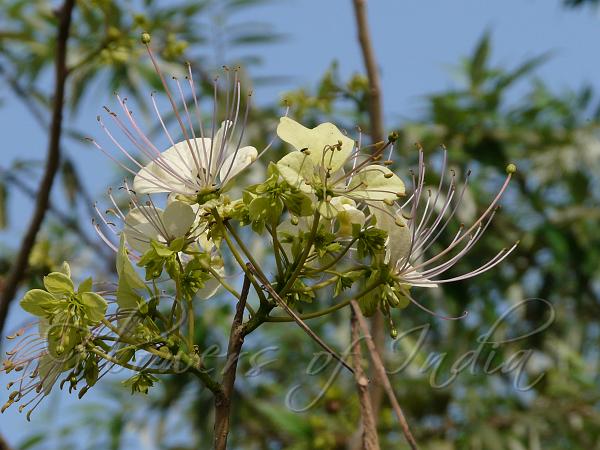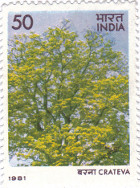|
| Garlic Pear Tree |
|

|

| File size | 2447182 |
| Original date | 4/11/08 7:54 AM |
| Resolution | 2560 x 1920 |
| Flash | Flash did not fire, auto |
| Focal length | 31.7mm |
| Exposure time | 1/400s |
| Aperture | 5.6 |
| Focus Distance | |
| Metering Mode | Multi-segment |
| Camera make | Panasonic |
| Camera model | DMC-FZ18 |
| Sensor type | OneChipColorArea |
|
|
|
Photo: |
Botanical name: Crateva adansonii subsp. odora Family: Capparaceae (Caper family)
 A moderate sized deciduous tree found throughout India, especially
along the river banks. Bark grey, smooth horizontally wrinkled. Leaves
trifoliate. Flowers white, or cream in many flowered terminal corymbs.
The bark is grey, and the wood is yellowish-white, turning light-brown
when old. The leaves are clustered at the ends of branchlets, with
a common petiole 5 to 10 centimeters long, at the summit of which are
tree leaflets. The leaflets are ovate-lanceolate or ovate, 7.5 to 12
centimeters long, 4 to 6 centimeters wide, and pointed at the base, with
a rather slender point at the tip. The flowers occur in terminal corymbs,
are about 5 centimeters in diameter, greenish-yellow, and the stamens are
purplish. The petals are ovate or oblong, with the claw half as long as
limb. The fruit is ovoid or rounded, and 3 to 5 centimeters in diameters,
with hard and rough rind. The seeds are about 10 centimeters in length,
numerous, kidney-shaped, and embedded in a yellow pulp.
A moderate sized deciduous tree found throughout India, especially
along the river banks. Bark grey, smooth horizontally wrinkled. Leaves
trifoliate. Flowers white, or cream in many flowered terminal corymbs.
The bark is grey, and the wood is yellowish-white, turning light-brown
when old. The leaves are clustered at the ends of branchlets, with
a common petiole 5 to 10 centimeters long, at the summit of which are
tree leaflets. The leaflets are ovate-lanceolate or ovate, 7.5 to 12
centimeters long, 4 to 6 centimeters wide, and pointed at the base, with
a rather slender point at the tip. The flowers occur in terminal corymbs,
are about 5 centimeters in diameter, greenish-yellow, and the stamens are
purplish. The petals are ovate or oblong, with the claw half as long as
limb. The fruit is ovoid or rounded, and 3 to 5 centimeters in diameters,
with hard and rough rind. The seeds are about 10 centimeters in length,
numerous, kidney-shaped, and embedded in a yellow pulp.
Medicinal uses:
 It is used in Indian Ayurvedic medicine.
It has anti-inflammatory, diuretic, lithontriptic, demulcent and tonic
properties. Bark yields ceryl alcohol, friedelin, lupeol, betulinic acid and
diosgenin. It is useful in disorders of urinary organs, urinary tract
infections, pain and burning micturition, renal and vesical calculi.
A postal stamp was issued by the Indian Postal Department to commemorate
this tree.
It is used in Indian Ayurvedic medicine.
It has anti-inflammatory, diuretic, lithontriptic, demulcent and tonic
properties. Bark yields ceryl alcohol, friedelin, lupeol, betulinic acid and
diosgenin. It is useful in disorders of urinary organs, urinary tract
infections, pain and burning micturition, renal and vesical calculi.
A postal stamp was issued by the Indian Postal Department to commemorate
this tree.| Identification credit: Rita Singh | Photographed in Delhi. |
• Is this flower misidentified? If yes,